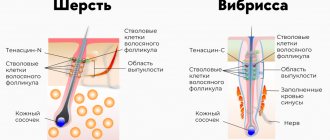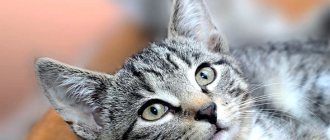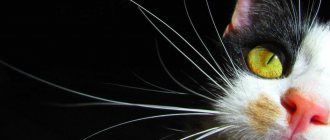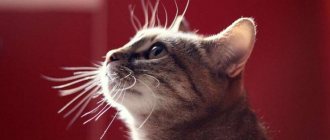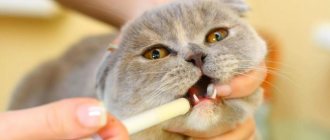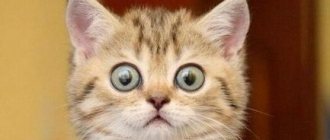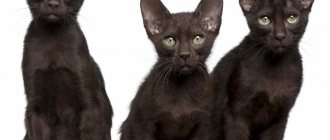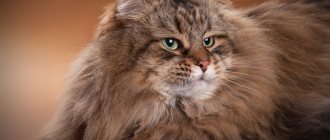What is the scientific name for a cat's whiskers?
Whiskers are the common name for the stiff hairs growing on the body of an animal. In fact, their scientific name is vibrissae, which comes from the Latin word vibro. Translated, it means “to waver” or “to wiggle.”
Indeed, the whiskers of cats, even in a calm state, tremble finely, that is, they vibrate. This is clearly noticeable if you look closely at your pet.
As a result of scientific research, it has been established that whiskers appeared on the body of the cat’s ancestors much earlier than they were overgrown with hair. In addition, observing the behavior of individuals helped to find out why the cat needed a mustache. Their presence is the main distinguishing feature of furry mammals.
The structure and location of the whiskers in cats
Whiskers have been present on the faces of both male and female individuals since birth. The presence of this important organ does not depend on breed or genetics. But the difference in the length and thickness of the whiskers is associated with individual characteristics: breed, sex of the individual, conditions of detention. Knowing their structure and location will help you find out why a cat needs a mustache.
What are they made of?
The long hairs on the cat's face have an interesting structure. Each whisker is connected to a specific part of the brain and is responsible for the functioning of a specific system of the animal. This is why a cat needs whiskers: from the signals from the whiskers in the pet’s head, a complete picture of what is happening is formed. The hairs themselves grow up to 5-7 cm and consist of:
- nerve endings;
- skin glands and epidermis (the part invisible to the eye);
- the vibrissa itself.
The thickness of the hair is explained by the large number of nerve endings and sometimes depends on gender. Because of these endings, a tubercle appears at the very base of the hair.
Luxurious mustaches are found in individuals whose owners take care of a balanced diet rich in vitamins and microelements. On average, the length of the hairs in both directions is equal to the width of the mustachioed friend’s body.
Whiskers are not only on the face!
It is a mistake to assume that cats' whiskers are located only on their faces. Long, thickened hairs can be seen on different parts of the fluffy's body. They differ in quality from the whiskers on the muzzle. Vibrissae in cats grow:
- above the eyes;
- in the nose area;
- on the chin;
- in areas around the lip pads.
In addition to the listed places, long hairs are located on the front legs, but they are practically invisible there. A curious owner of a mustachioed pet can carefully examine the paw slightly above the area of the dewclaw (pad without a claw). This is where thickened hair grows. Why a cat needs whiskers on these parts of the body can be understood by observing the habits of a furry friend.
General information
A cat's eyebrows are also vibrissae. The average length of a cat's whiskers is 7 cm. But there are exceptions, for example, the Maine Coon breed. In cats of this breed, the whiskers are similar to hair, but several times longer.
The vibrissa is immersed in the hair follicle and surrounded by veins. Each vibrissa has its own area in the brain. Vibrissae, unlike ordinary hairs, have a tactile function and are responsible for sensation. Vibrissae trap air currents.
These are the animal's tactile receptors. Vibrissae from the Latin vibrisse, meaning to vibrate. With their help, cats determine the position of an object, obstacles, and navigate in the dark. Nerve impulses from the whiskers are sent to the brain, which processes the signals sent by this system and creates the surrounding picture.
Vibrissae help the cat to get acquainted and receive information about objects and other animals. The cat approaches an unfamiliar object, pointing its whiskers forward. With their help, the cat determines atmospheric pressure, temperature and humidity. The animal determines all this by slightly moving its whiskers.
Vibrissae help the animal avoid damage to the eyes, assess the speed and direction of the wind, and control the temperature of surfaces. The cat may not see the approaching object, but the whisker will definitely feel the air flow reflected from it.
Interesting! Vibrissae are one of the first hairs that a kitten develops in the womb of a cat mother.
Vibrissae serve as an indicator of the animal's mood. If the whiskers are directed forward, then the animal is showing interest in something and is ready for active action. If the whiskers are pressed to the muzzle, then the cat is aggressive or scared. Vibrissae, like ordinary hair, fall out.
If a cat has lost several whiskers, then there is no need to worry, and on the contrary, you should pay attention if the whiskers leave the cat’s face in large quantities. Excessive fragility is associated with any stress experienced, an unbalanced diet, or dehydration of the animal’s body.
Why do cats and cats need whiskers?
It is clear that whiskers are not just hair on a pet’s body. They play an important role in the life of a furry individual.
Help in hunting
In ancient times it was believed that the length of the whiskers indicated hunting habits. The longer the hairs on the face, the better the cat catches rats and mice.
This fact has no scientific confirmation. But it is obvious that thick shoots are the pet’s main assistants during the hunt. Thanks to them, cats quickly pick up even small vibrations in the air that are created by a running rodent.
The furry hunter easily determines where the prey is and where it is moving. After the rodent is caught, the cat's antennae on its front legs help it retain its prey and control its behavior.
Orientation in space
Fluffy purrs are well known for their ability to move silently and deftly even in complete darkness. At such moments, it is not the eyes or ears that help the animal. The cat uses its whiskers to touch objects and avoid obstacles.
When touching surrounding things, the hairs vibrate, creating air movements. These signals are picked up by the whiskers and transmitted to a specific part of the brain. This is how the pet forms a three-dimensional picture of what surrounds it.
Tactile function
Touch is the main purpose of vibrissae. They help the fluffy one accurately determine the freshness of food and the safety of products. Before starting to eat, the cat will feel the food with its whiskers (sniffing movement) and only then begin to eat.
Signals in communication
It is easy to understand why a cat needs a mustache in those moments when the animal wants to communicate. If you look closely at your furry friend, you will notice the movement of the antennae. The vibrissae change direction in relation to the person or object of interest to the cat.
Whiskers pointed forward indicate the purr's desire to explore an object or desire to communicate with a living creature. Animals also collect antennae while playing or hunting.
A man sells his cat's whiskers. The mustache is natural. 100 rubles per piece
A certain Semyon from Perm recently published a message on Avito that he was selling his cat’s whiskers. The seller explained that he did not pull out the mustache, it fell out on its own. You can buy with delivery and on credit.
The product is in demand and many media outlets have already written about the fact of their sale. Judging by the photo on the website, the mustache is neatly folded in a bag. There are more than 20 of them. The price for one mustache is 100 rubles. The vibrissae belong to two of Semyon’s pets: a cat and a Scottish cat.
In one of the interviews, the man said that his wife and child constantly find fallen mustaches in the apartment. Thus, we decided not to throw it away and collect it. The head of the family suggested that such material could be useful for someone. Posted it on Avito. The first potential buyer was a musical instrument maker. But I never purchased the material...
What happens if you cut off a cat's whiskers?
Since the whiskers are the vital organs of a pet, their loss leads to great difficulties. What happens if you trim a cat's whiskers?
Physiological or mental disorders
If a cat loses its tactile organ, then problems with its physiological and mental health are possible. It is known that without vibrissae the animal is poorly oriented in space. This occurs due to lack of information about the environment.
The cat begins to bump into objects and get stuck in passages that are too narrow. Cats cannot jump from one object to another. They are not able to fully hunt and obtain food. The loss of antennae is especially dangerous for yard representatives.
Often cats that are deprived of sensitivity become nervous and withdrawn. The mental state of the animals deteriorates sharply. They begin to avoid people around them, try to hide, or behave inappropriately.
Do cats grow whiskers?
Having found out why a cat needs a mustache, a person understands that cutting them is unacceptable. They are cut off only in case of injury or infection of nearby tissues. The procedure is carried out by a veterinarian to treat the problem area and prevent the development of complications.
Vibrissae are able to recover, but only if there is no damage to the hair follicle. Trimmed whiskers grow back in an average of 2-3 weeks, but sometimes the time period increases.
Old frying pans and pots
You never know what circumstances there are! I remember about 25 years ago, my friend and I were driving through Moscow to the Grushinsky festival. We had to spend more than a day in the capital, there was no money for a hotel, and therefore it was decided to pitch a tent in the nearest Moscow region. At the station square it dawned on us: there was no pot. “Now we’ll buy an inexpensive saucepan somewhere nearby,” the friend reassured. But “nearby” it turned out to be a not at all cheap Moscow department store, where the aluminum saucepan was bought for a lot of money. It was a pity - not the right word, but what to do?
Now it’s easy to buy a saucepan for camping on a free classifieds site - you save money and don’t mind throwing it away later. There are dozens of proposals. Mikhail from Yekaterinburg is the owner of a whole collection of such “aluminum scrap”. There are miniature ones, as well as 8 liters for a respectable company. Price - from 50 to 200 rubles per piece.
Source of the article: https://www.wday.ru/dom-eda/interer/kto-eto-pokupaet-usy-kota-i-drugoi-khlam-kotoryi-prodayut-v-seti/
Problems with whiskers in cats
Having understood why a cat needs a mustache, the owner pays attention to their condition. Brittleness or loss of whiskers indicates problems with the pet's health and indicates a low quality of life.
They break down
The fragility of tactile hairs occurs due to an uncomfortable environment. For example, too dry indoor air negatively affects the condition of the organ and leads to its breakage. Brittleness also occurs due to insufficient consumption of fresh water.
You should not bathe your fluffy often. Chlorine in water and chemicals in pet shampoos negatively affect the elasticity of the whiskers.
Normalizing the humidity in the room, as well as constant access to clean drinking water, will help prevent further breakage. To wash your pets, you should use only high-quality products containing natural ingredients.
Fall out on their own
If brittle hairs indicate problems with the environment, then hair loss is a serious reason to think about your pet’s health. In some cases, hair loss indicates a food allergy.
Allergies often occur to whole milk or fish. In addition to the loss of whiskers, the cat begins to lose hair. Digestive problems arise, and tears begin to flow from the eyes of the allergic person. Such symptoms are a signal for the owner to review the animal’s diet. A visit to a veterinary clinic will help identify the allergen.
Loss of whiskers may also indicate vitamin deficiency. The lack of important microelements and vitamins in the diet and the monotony of the diet cause massive hair loss. Knowing why a cat needs a mustache, the owner must provide the animal with all the elements for the proper functioning of the body.
Another cause of loss is infection with intestinal parasites. Intoxication with their waste products affects the penetration of nutrients into the antennae. This provokes the death of the follicle and loss of the vibrissa.
Infection with skin fungus also occurs. Itchy areas appear around the whiskers, which peel off and gradually lose hair. All these problems require timely treatment prescribed by a veterinarian.
Grows slowly and poorly – or not at all
Slow hair growth indicates poor pet health. Short vibrissae indicate a serious lack of vitamins and microelements in the body.
Sometimes slow and poor growth of thick hairs is a sign of a metabolic disorder or a symptom of an endocrine disease. If the addition of a vitamin-mineral complex does not lead to an improvement in the quality of the whiskers, then consultation with a veterinarian is necessary.

